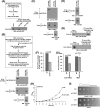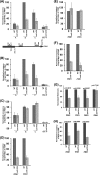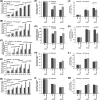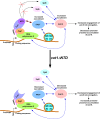An mRNA Capping Enzyme Targets FACT to the Active Gene To Enhance the Engagement of RNA Polymerase II into Transcriptional Elongation
- PMID: 28396559
- PMCID: PMC5472824
- DOI: 10.1128/MCB.00029-17
An mRNA Capping Enzyme Targets FACT to the Active Gene To Enhance the Engagement of RNA Polymerase II into Transcriptional Elongation
Abstract
We have recently demonstrated that an mRNA capping enzyme, Cet1, impairs promoter-proximal accumulation/pausing of RNA polymerase II (Pol II) independently of its capping activity in Saccharomyces cerevisiae to control transcription. However, it is still unknown how Pol II pausing is regulated by Cet1. Here, we show that Cet1's N-terminal domain (NTD) promotes the recruitment of FACT (
Keywords: Cet1; FACT; RNA polymerase II; mRNA capping; transcription.
Copyright © 2017 American Society for Microbiology.
Figures







Similar articles
-
Acetylation-Dependent Recruitment of the FACT Complex and Its Role in Regulating Pol II Occupancy Genome-Wide in Saccharomyces cerevisiae.Genetics. 2018 Jul;209(3):743-756. doi: 10.1534/genetics.118.300943. Epub 2018 Apr 25. Genetics. 2018. PMID: 29695490 Free PMC article.
-
A novel role for Cet1p mRNA 5'-triphosphatase in promoter proximal accumulation of RNA polymerase II in Saccharomyces cerevisiase.Genetics. 2014 Jan;196(1):161-76. doi: 10.1534/genetics.113.158535. Epub 2013 Oct 30. Genetics. 2014. PMID: 24172134 Free PMC article.
-
Cap completion and C-terminal repeat domain kinase recruitment underlie the initiation-elongation transition of RNA polymerase II.Mol Cell Biol. 2013 Oct;33(19):3805-16. doi: 10.1128/MCB.00361-13. Epub 2013 Jul 22. Mol Cell Biol. 2013. PMID: 23878398 Free PMC article.
-
[Molecular mechanisms of transcription through a nuclesome by RNA polymerase II].Mol Biol (Mosk). 2013 Sep-Oct;47(5):754-66. Mol Biol (Mosk). 2013. PMID: 25509347 Review. Russian.
-
Causes and consequences of RNA polymerase II stalling during transcript elongation.Nat Rev Mol Cell Biol. 2021 Jan;22(1):3-21. doi: 10.1038/s41580-020-00308-8. Epub 2020 Nov 18. Nat Rev Mol Cell Biol. 2021. PMID: 33208928 Review.
Cited by
-
FACT is recruited to the +1 nucleosome of transcribed genes and spreads in a Chd1-dependent manner.Mol Cell. 2021 Sep 2;81(17):3542-3559.e11. doi: 10.1016/j.molcel.2021.07.010. Epub 2021 Aug 10. Mol Cell. 2021. PMID: 34380014 Free PMC article.
-
Genome-Wide Regulations of the Preinitiation Complex Formation and Elongating RNA Polymerase II by an E3 Ubiquitin Ligase, San1.Mol Cell Biol. 2022 Jan 20;42(1):e0036821. doi: 10.1128/MCB.00368-21. Epub 2021 Oct 18. Mol Cell Biol. 2022. PMID: 34661445 Free PMC article.
-
Interplay of mRNA capping and transcription machineries.Biosci Rep. 2020 Jan 31;40(1):BSR20192825. doi: 10.1042/BSR20192825. Biosci Rep. 2020. PMID: 31904821 Free PMC article. Review.
-
The histone chaperone FACT: a guardian of chromatin structure integrity.Transcription. 2022 Feb-Jun;13(1-3):16-38. doi: 10.1080/21541264.2022.2069995. Epub 2022 Apr 29. Transcription. 2022. PMID: 35485711 Free PMC article. Review.
-
Proteasomal Regulation of Mammalian SPT16 in Controlling Transcription.Mol Cell Biol. 2021 Mar 24;41(4):e00452-20. doi: 10.1128/MCB.00452-20. Print 2021 Mar 24. Mol Cell Biol. 2021. PMID: 33526453 Free PMC article.
References
MeSH terms
Substances
Grants and funding
LinkOut - more resources
Full Text Sources
Other Literature Sources
Molecular Biology Databases
